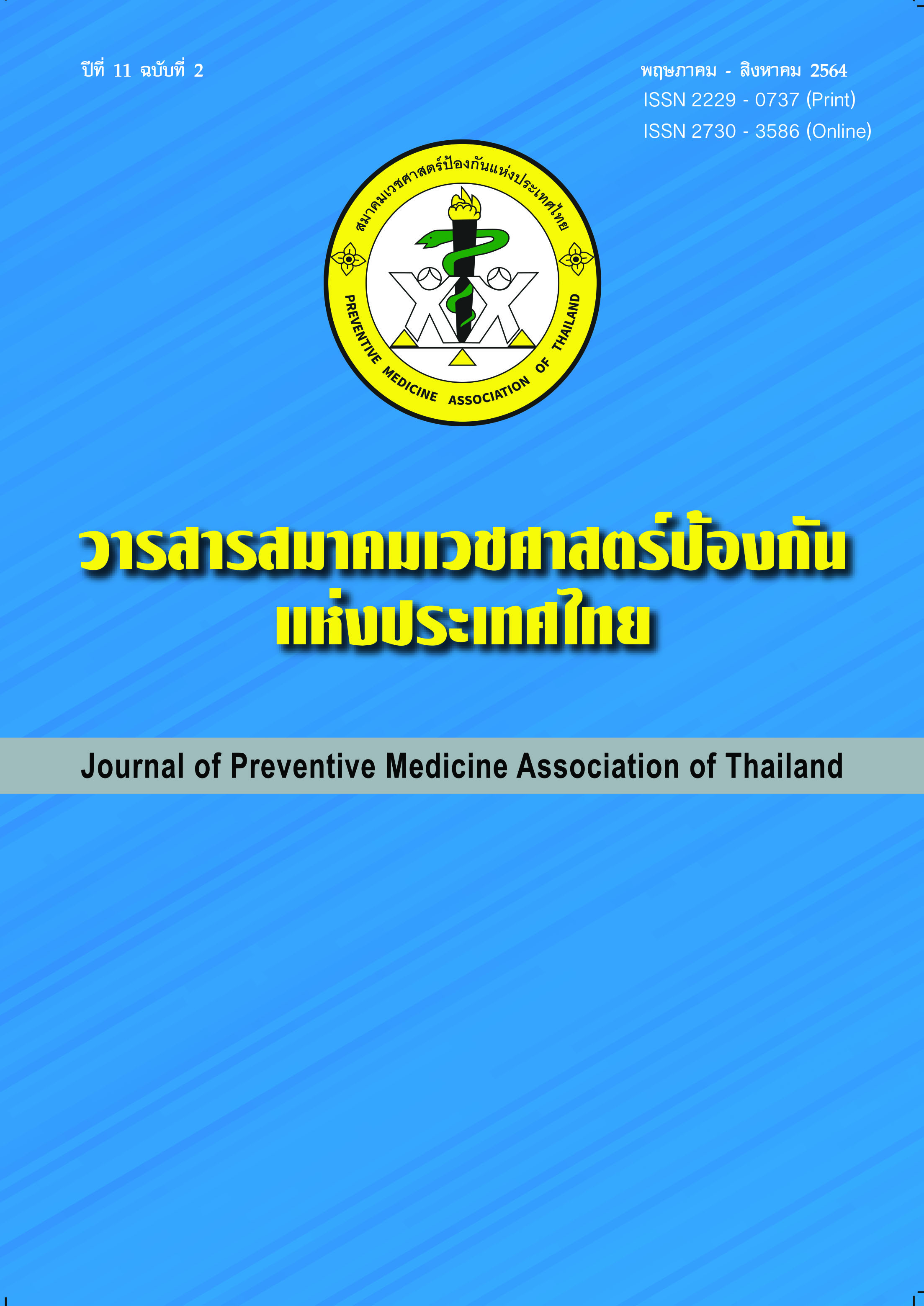Factors Associated with Intracerebral Hemorrhage after Treatment with Recombinant Tissue Plasminogen Activator for Acute Ischemic Stroke in Phra Nakhon Sri Ayutthaya Hospital
Keywords:
Acute ischemic stroke, Thrombolytic, recombinant tissue-type plasminogen activator, rt-PA, Intracerebral hemorrhageAbstract
Acute ischemic stroke is a common neurological disorder. Nowadays, intravenous recombinant tissue-type plasminogen activator (rt-PA) is a thrombolytic drug that is recommended for treatment of patients with acute ischemic stroke who came to the hospital within 4.5 hours. The major and serious side effect of rt-PA is intracerebral hemorrhage (ICH). Before giving rt-PA, doctors had to check contraindications of this drug. Although patients receiving rt-PA had no contraindication, some of them suffered from ICH after the treatment with rt-PA. Nowadays, there are many researchs to find out which factors related to ICH after receiving rt-PA, but different factors were found in each study. Many researchs were studied in other countries but only a few researchs were studied in Thailand.
Objective: To determine risk factors associated with ICH after treatment with rt-PA for acute ischemic stroke in patients admitted in Phra Nakhon Sri Ayutthaya Hospital.
Method: This study is a retrospective observational study. We reviewed all patients with acute ischemic stroke who received treatment with rt-PA within 4.5 hours of stroke onset at stroke unit, Phra Nakhon Sri Ayutthaya hospital, Thailand during October 2017 and August 2020. There were 153 patients in this study. Patients were devided into two groups upon occurring ICH and no ICH within 24 hours after treatment with rt-PA. Baseline characteristics, vital signs, and other factors were collected, analyzed, and compared between two groups. Correlative factors were analyzed by using multivariable logistic regression analysis.
Outcomes: There were 153 patients receiving rt-PA. 22 patients (14.4%) developed ICH. This study showed that 4 baseline factors were significantly associated with ICH. First, prior clopidogrel using increased risk of ICH (OR 13.364, p = 0.008). Second, high baseline National Institutes of Health Stroke Scale (NIHSS) was increasing risk of ICH (OR 1.132, p = 0.013). Third, high capillary plasma glucose (CPG) was linked with risk of ICH (OR 1.012, p = 0.011). Finally, history of receiving antihypertensive drug (IV Nicardipine) for decreasing blood pressure below 185/110 mmHg before infusion of rt-PA was significantly associated with ICH (OR 10.805, p = 0.003).
Conclusion: Clopidogrel using, high baseline NIHSS, high CPG and history of receiving intravenous antihypertensive drug before infusion of rt-PA related to ICH after treatment with rt-PA. So If patients have one or more of these factors, doctor should aware and prepare initial treatments before giving rt-PA to the patients.
References
Suwanwela NC. Stroke epidemiology in Thailand. J stroke 2014;16:1-7.
กลุ่มยุทธศาสตร์และแผนงานสำนักโรคไม่ติดต่อ กรมควบคุมโรค.รายงานประจำปีสำนักโรคไม่ติดต่อ กรมควบคุมโรค กระทรวงสาธารณสุข 2559. นนทบุรี: กรมควบคุมโรค; 2560.
สำนักงานพัฒนานโยบายสุขภาพระหว่างประเทศ. การสูญเสียปีสุขภาวะ Disability-Adjusted life year : DALY รายงานภาระโรคและการบาดเจ็บของประชากรไทย พ.ศ. 2556. นนทบุรี: สำนักงานพัฒนานโยบายสุขภาพระหว่างประเทศ; 2558.
McKinney JS, Cucchiara B. Risk scores for predicting post-thrombolysis intracerebral hemorrhage. US Neurology 2010;5:39-40.
Jauch EC, Saver JL, Adams HP, Bruno A, Connors JJ, Demaerschalk BM, et al. Guidelines for the early management of patients with acute ischemic stroke: a guideline for healthcare professionals from the American Heart Association/American stroke Association. Stroke 2013;44:870-947.
Powers WJ, Rabinstein AA, 2018 guildelines for the early management of patients with acute ischemic stroke: a guideline for healthcare professionals from the American Heart Association/American Stroke Association. Stroke 2018;49:e47-e99.
Cucchiara B, Kasner SE, Tanne D, Levine SR, Demchuk A, Messe SR, et al. Factors associated with intracerebral hemorrhage after thrombolytic therapy for ischemic stroke: pooled analysis of placebo data from the Stroke-Acute Ischemic NXY Treatment (SAINT) I and SAINT II trials. Stroke 2009;40:3067-72.
Echouffo-Tcheugui JB, Woodward M, Kengne AP. Predicting a post-thrombolysis intracerebral hemorrhage: a systematic review. J Thromb Haemost 2013;11:862-71.
Guo Y, Yang Y, Zhou M, He L. Risk factors of hemorrhagic transformation for acute ischaemic stroke in Chinese patients receiving intravenous recombinant tissue plasminogen activator: a systematic review and meta-analysis. Stroke Vasc Neurol 2018;3:203-8.
Sivanandy P, Thomas B, Krishman V, Arunachalam S. Safety and efficacy of thrombolytic therapy using rt-PA (alteplase) in acute ischemic stroke. ISRN Neurol 2011;2011:618-24.
Phuttharak W, Sawanyawisuth K, Sangpetngam B, Tiamkao S, Kongbunkiat K, Chotmongkol V, et al. Risk factors for intracerebral hemorrhage after treatment with recombinant tissue-type plasminogen activator for acute ischemic stroke. Asian Biomedicine 2015;9:397-400.
สุจริต สวนกูล, ธานินทร์ โลเกศกระวี. ปัจจัยที่มีผลต่อภาวะเลือดออกในสมองภายหลังการให้ยาละลายลิ่มเลือดทางหลอดเลือดดำในผู้ป่วยโรคหลอดเลือดสมองตีบหรืออุดตันเฉียบพลัน. ลำปางเวชสาร 2559;37:67-77.
Mazya MV, Lees KR, Collas D, Rand V, Mikulik R, Toni D, et al. IV thrombolysis in very severe and severe ischemic stroke: Results from the SITS-ISTR Registry. Neurology 2015;85:2098-106.
Miller DJ, Simpson JR, Silver B. Safety of thrombolysis in acute ischemic stroke: a review of complications, risk factors, and newer technologies. Neurohospitalist 2011;1:138-47.
Dharmasaroja PA, Muengtaweepongsa S, Pattaraarchachai J, Dharmasaroja P. Intracerebral hemorrhage following intravenous thrombolysis in Thai patients with acute ischemic stroke. J Clin Neurosci 2012;19:799-803.
Southerland AM, Johnston KC. Considering hyperglycemia and thrombolysis in the stroke hyperglycemia insulin network effort (SHINE) trial. Ann N Y Acad Sci 2012;1268:72-8.
Bhurayanontachai R. Glycemic control in critically ill patients. Songkla Med J 2006;24:333-45.
Hafez S, Coucha M, Bruno A, Fagan SC, Ergul A. Hyperglycemia, acute ischemic stroke and thrombolytic therapy. Transl Stroke Res 2014;5:442-53.
Downloads
Published
How to Cite
Issue
Section
License
บทความที่ลงพิมพ์ในวารสารเวชศาสตร์ป้องกันแห่งประเทศไทย ถือเป็นผลงานวิชาการ งานวิจัย วิเคราะห์ วิจารณ์ เป็นความเห็นส่วนตัวของผู้นิพนธ์ กองบรรณาธิการไม่จำเป็นต้องเห็นด้วยเสมอไปและผู้นิพนธ์จะต้องรับผิดชอบต่อบทความของตนเอง






